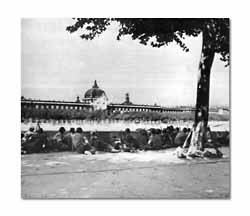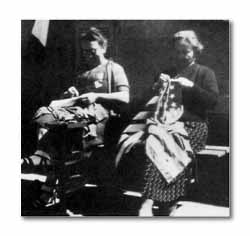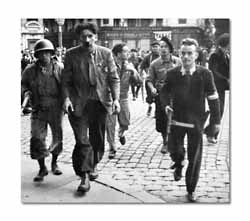| The period of swift-striking, highly-motorized
warfare was not yet at an end. After the Montelimar grip had been loosened, the 36th
streaked northward 80 miles in three days toward Lyons, largest silk-manufacturing center
in the world and the second city of industrial importance in France. Reconnaissance
elements led the regiments to the east of the city, instructions limiting entrance only to
liaison parties contacting the Maqui within. On
September 2 the 142nd and 143rd closed in on Lyons proper. During the afternoon, Gen.
Dahlquist ordered a patrol to scout the town. The patrol reported that the Maqui had
cleared the Germans from the areas before the bridge sites of the Rhone river, running
through the heart of the city. How many spans remained intact could not be determined at
first, but our troops, later sent in to secure the sites, discovered that the enemy had
blown every bridge across the Rhone within Lyons.
As the Division established roadblocks east
and northeast of Lyons, bridge reconnaissance parties from the 111th Engineer Battalion
made their way into the city after being delayed by one skirmish. A heated clash
was in progress on the west side of the Rhone between the Maqui and the Milice, Vichy
police despised by the French Patriots. One whole section of the city, the industrial
area, was their battleground.
But on the near side of the river our
patrols were greeted by thronging groups of civilians who came out to applaud their
liberation. The elderly shook hands and threw flowers; the young sought autographs and
climbed aboard jeeps and trucks. That evening Gen. Gahlquist placed a guard of honor at
the disposal of the mayor at the town hall.
Initially, it appeared as though Lyons might
have to undergo a lengthy siege, but on September 3 it became apparent that the Germans
were withdrawing. In several of the factories fires still raged; in some districts the
Milice continued to resist extermination. The Maqui were left to the mop-up mission while
the 36th moved out, making a 30-mile detour eastward to cross the Rhone and catch the
enemy before he reached his prepared defenses.
|
|

| 36th Division men, partisons, and armed civilians fire back at
German snipers across the Rhone River. |

The French women made American flags.
|

| A member of hated Vichy Milice, who battled with the FFI and
the Americans, is captured and led away. |
|